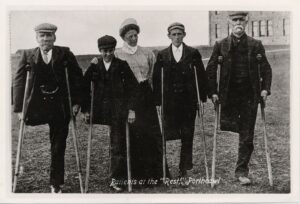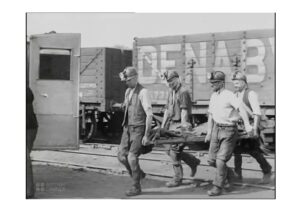BLOG 5 – DEATH AND TRAUMA
“In the nineteenth century, many miners were ‘cured’ by having the problem amputated. The limited skills of some colliery surgeons and more general the inability of orthopaedics to carry out the complex repairs to limbs that came in the post-war period meant that amputation was often the easiest or indeed the only option.”

Patients at the Rest Convalescent Home, Porthcawl. Image courtesy of Richard Burton Archives, Swansea University

Screenshot – They Live Again, British Council: injured miner being carried to ambulance
The British Coal Industry early 20th Century
In the mid-1920s mining was the most dangerous of all major industries; with roughly 5% of the working population it had 25% of all industrial accidents.
In 1923, 1,297 miners were fatally injured and 212,256 men had injuries disabling them for more than 7 days.
8,944 miners lost their lives between 1930 and 1939.

Table – number of miners killed 1930 – 1939
The Royal Commission on Safety in Mines 1935 – 8, found no change in the general level of accidents for the previous 15 years and during the 3 years of its Inquiry, 850 miners had died.
The Nottingham Journal in 1942 reflected on,
“the sights we used to see in mining villages, of men with injured spines and other fractures, becoming simply human derelicts.”
Screenshot from British Council’s, ‘They Live Again’, Treatment for compressed fracture of the spine



Even up and till closure the mining industry was a dangerous occupation not with just external injuries which varied in severity but internally the damage could be just as severe with COPD a life threatening lung condition this in its self could relegate men to alot less paid jobs. You could bet during the course of a month sometimes less that loco transport was required to bring an injured man out of the mine on arrival at the pit top the nursing sister would be there ready to give immediate treatment and the NCB ambulance would be waiting this in its self was better than years ago importantly the nature of injuries were the same the methods of dealing with them had changed.
Thanks for your important comments Barrie.